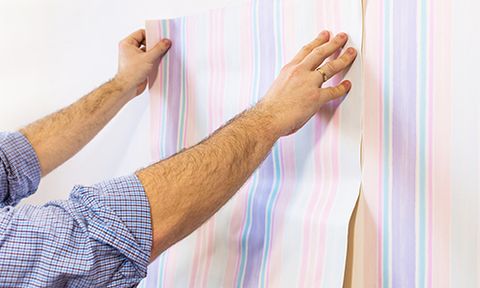Overlap and cut both pieces at once, Reduce the middle of the overlap, Lap one panel over the other, and cut down the middle of the overlap. Angle the knife blade down low so more than just the idea of the blade is doing the cutting. Often, instead of butting one panel up to another, you'll require to develop your own seam.
Bob prefers a 10-in. knife so he doesn't need to move it as often as he would a smaller one. Hold the knife down near the wall to avoid cutting into the ceiling. Make relief cuts prior to cutting, Use a scissors for relief cuts, Use a scissors instead of a knife to avoid mistakenly cutting into wood trim and other challenges.

Task information Skill 3 out of 5 Moderate Not so bad for somebody with persistence and precision, which are crucial to hanging paper directly, plumb, and completely aligned. Wallpaper initially appeared in the 16th century, in the form of black-and-white hand-blocked prints, and it stays a preferred way to bring color, texture, and personality to a home.
The Basic Principles Of Wallpaper Installation Services - Certapro Painters®
According to John Dee, these are simpler to deal with than more delicate and tear-prone plain paper, and usually come pre-pasted, eliminating the need to roll on starch-based adhesives. They can, however, be harder to cut and require bonding with vinyl-to-vinyl adhesive. Idea: Silk, turf, cloth, and textured papers also require cautious attention during setup: "You absolutely can't get paste on their faces," Dee says.

Step the width and height of this wall and mark its midpoint. Cut a brief strip of wallpaper. wallpaper installation. Location the dominant aspect over the midpoint. Mark the wall at the paper's leading edge, the edge against which the next strip will hang. Using a 4-foot level, draw a plumb line at that mark.
To offer the adhesive a chance to trigger, carefully fold over both ends of the strip, bewaring not to crease the paper, so that they meet in the middle; this process is called "booking." Make certain the paper's edges are exactly lined up so that no pasted surface area is exposed (local wallpaper hangers).
Phillip Jeffries - The World's Leader In Natural, Textured ... Things To Know Before You Buy
For pre-pasted paper, loosely roll up a strip with the adhesive side out and immerse it in a trough of cold to lukewarm water, depending on the producer's directions, simply till the paper is thoroughly damp (however no longer). Reserve the paper as above for 3 to 5 minutes. Step 4: Hang the First Strip Take the scheduled strip to the wall, then unfold and use the leading half, aligning one edge with the plumb line in Step 2.
Overlap a patterned paper as needed so that the main design component is focused on the midpoint of the wall section. Smooth the edges of the paper with a damp sponge, then brush gently from the center of the strip to its edges. Next, gently pull (do not push) a smoother across the paper to remove wrinkles and anchor the paper to the wall.
Measure, cut, and hang each subsequent strip, sliding them up or down on the wall to align the pattern and to butt joints firmly with no overlaps. Step 6: Wallpaper the Corners Corners are the only places where strips overlap. For an inside corner, step from the corner to the top, middle, and bottom of the last-pasted strip.
Examine This Report on What Is Peelable Wallpaper?
Using a level, cut a dry strip to that width, cutting the edge that'll satisfy the corner. Hang the paper so the just-cut edge turns the corner and extends onto the adjacent wall. Position the adjacent strip with its edge inside the corner, overlapping the previous strip; line up the patterns.

Using the line as a guide, hang this strip. For outside corners, trim the strip to wrap over the next wall by inch. Hang the next strip so it overlaps the previous piece however lands short of the corner. This avoids the paper from peeling if somebody brushes against the corner.
From the paper's waste edge to the corners of the trim, make diagonal cuts with scissors to permit the paper to lay flat on the wall. Get rid of the bulk of the overlap with scissors. Smooth the paper as in Action 4, then utilize the smoother to press the paper comfortably against the case, the ceiling, and the baseboard.
10 Things You Should Know About Hanging Wallpaper - Diy ... - The Facts
Step 8: Cut Around Window Apron To trim around a window's stool and apron, make a series of short cuts from the waste edge of the strip towards the corner where wall and stool satisfy. These narrow fingers of paper allow the strip to be shaped to the profile of the case.
Get step-by-step directions on how to hang embossed and basic wallpaper - wallpaper hanger.
• check my siteclick here to readHomepage